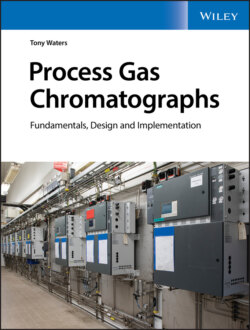Читать книгу Process Gas Chromatographs - Tony Waters - Страница 47
A peak appears
ОглавлениеAn important thing just happened.
In Figure 2.4c, notice that the same percentage of the molecules dissolved in the liquid phase even when there were fewer molecules available; the solubility ratio is constant. In our example, for instance, we always end up with exactly half of the propane molecules dissolved in the liquid phase. Constant solubility is a very useful property of liquid phases because it generates symmetrical peak shapes. You are about to see how that happens.
There are some rare exceptions to the rule of constant solubility. When solubility varies with solute concentration, some adverse distortion of peak shape occurs that you will need to recognize when troubleshooting. This isn't the time to discuss the problem, so let's leave it for later.
In Figure 2.4 there's only one small enclosed space where an equilibrium forms and is quickly disrupted by the movement of the carrier gas. Now imagine that a column has lots of these small enclosed spaces arranged in series, as depicted in Figure 2.5, so the gas leaving one of the spaces enters the next one, where it encounters fresh clean liquid. It then quickly forms a new equilibrium.
The upper diagram shows how the carrier gas movement carries the propane molecules into the next part of the column, where it encounters fresh liquid phase. The lower diagram imagines that the carrier gas stops for a moment to allow two equilibria to form, each one involving only half of the original molecules.
Figure 2.5 The Second Equilibrium.
The lower section of Figure 2.5 shows the first two of these equilibria side by side. So far, it's not very interesting because not much has happened; the original molecules have divided into four equal parts.
But they don't stay that way for long; again, the carrier gas moves. Figure 2.6 shows this movement and the formation of the third equilibrium. Look closely at the third equilibrium. The distribution of the propane molecules in the gas phase is now 4:8:4. Already, a peak has appeared!
Again, the upper diagram shows the movement of the carrier gas, which carries all the propane molecules to the next part of the column. The lower diagram then shows how three new equilibria form, but the center one contains half of the original molecules.
Figure 2.6 The Third Equilibrium.
In Figure 2.7, the process continues and forms four new equilibria. Notice that each time the carrier gas moves, the number of molecules in the original small enclosed space is reduced by a factor of two. Clearly, if this same division recurs many times over, all those molecules will soon be gone − even if starting from a very large number of molecules.
Again, the upper diagram shows the movement of the carrier gas. The lower diagram then shows how four new equilibria form. Notice that each time the carrier gas moves, the molecule population in both the far left and far right equilibria divides by two and is rapidly disappearing.
Figure 2.7 The Fourth Equilibrium.
Notice also, that the same rapid reduction occurs in the leading edge of the band of molecules. This repetitive reduction of the number of molecules distant from the band center quickly focuses the molecules into a narrow symmetrical peak.
Finally, Figure 2.8 shows how the stepwise motion of the carrier gas has gradually shaped the peak until it starts to look like a real chromatogram peak. Be sure to understand what's happening here.
Again, the upper diagram shows the movement of the carrier gas. The lower diagram then shows how five new equilibria form. The molecule distribution is now in the shape of a peak with the highest concentration of molecules at the center, and the lowest concentration at the edges. This is how real peaks form in columns.
Figure 2.8 The Fifth Equilibrium.
It's important to realize that the carrier gas present during the original sample injection has traveled down the column and is now in the fifth equilibrium. This progression of the carrier gas through the five equilibria is indicated by the white background color in Figures 2.5 through 2.8.
By the time the carrier gas reaches the fifth equilibrium, most of the propane molecules have been left behind; only one stayed with the carrier gas during the five moves considered so far. The distribution of propane molecules in the gas phase is now 1:4:6:4:1, and the peak concentration is right at the middle. Notice that the average rate of movement of a propane molecule is half the speed of the carrier gas. If you are following closely, you'll realize why. The propane solubility is 50 %, so at any instant of time only half of the molecules are in the gas phase, moving. The other half are stationary.
